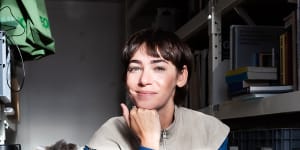
Laura Clauscen,a public art curator with Tilt Industrial Design.Supplied
9am:My job is to support artists to develop concepts and designs for public art projects. I start my day at my desk,analysing a new public art brief for deliverables including budget,location,technical parameters,site context and submission requirements.
I like to extract all the key information and set up a Miro board where the Tilt team can collaborate visually with the artist.
We are trying to explore new ways of making public art that has a cross-disciplinary outcome. We’re really interested in trying to push the envelope using industrial design thinking. The artist comes up with the concept and direction,and we support them to push it to its greatest potential.
Sometimes,I’ll approach an artist with an email asking if they’d like to build a team for a public art opportunity. Other times artists visit Tilt once they have been shortlisted,to develop a concept design as part of a competitive selection process.
Public art projects are not quick. They can last anywhere from one year to five years. For me,this means there’s a lot of picking things up and putting them down across about 25 projects at once.
10am:A big part of my role is to help artists work with our industrial designers and engineers to translate their artistic practice and vision into something that will work in the built environment.
There’s a lot of communication involved. Today,I jump on a Teams call with an artist and one of our industrial designers to discuss using blue marble for a wall relief. The artist is inspired by scholars rocks and Qing (blue-green) hues. She wants to make the work from “carved earth”,responding to the site brief.
11am:Next is a kick-off meeting on a public art brief for Sydney Metro. The concept design phase for a public art project may run from four to 12 weeks depending on the scope and scale. There’s a lot to weave together,and we have to make sure we celebrate the artist’s point of difference in the context of the brief.
Public art policies and regulations can be strict. Often in a brief the commissioner will provide a list of the materials they are expecting you to choose from.
Innovation and experimentation with materials is an area we are always interested in. Of course,this is challenging as public artworks generally need to have a lifespan of at least 25 plus and be highly durable and maintainable.
1pm:Next is a catch-up with a Kamilaroi/Gamilaraay artist we are working with. He’s interested in casting sculptural works and bench seats in concrete using an aggregate of shells collected by community around the site of the project.
I’m not just interested in how a story is expressed through form,but I’m interested in how it’s expressed through material. I love working with artists through that process of exploration.
5pm:As I finish my day with another round of emails to artists on various projects,I am reminded of the impact good public art can have. With willing clients,ambitious artists and an interdisciplinary delivery team,public art can be thought-provoking,experiential and emotive.
The discipline in Australia is expanding and technology is coming into public art in a big way,but I think we could be doing much better. There’s a real opportunity to be collaborating with other built environment practitioners like landscapers,architects,wayfinding designers and other disciplines.
The Business Briefing newsletter delivers major stories,exclusive coverage and expert opinion..